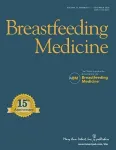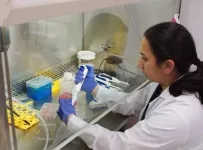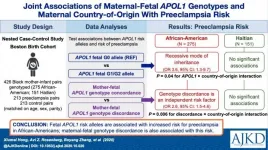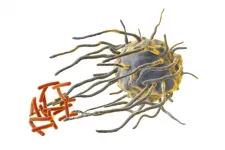Mechanisms in the kidney that control magnesium and calcium levels discovered
A mutation in the gene KCTD1 leads to kidney defects that can ultimately cause metabolic bone disease
2021-01-12
(Press-News.org) BOSTON - While investigating the underlying causes of a rare skin disorder, a researcher at Massachusetts General Hospital (MGH) discovered a previously unknown mechanism in the kidneys that is important for regulating levels of magnesium and calcium in the blood.
The discovery, described in the journal Cell Reports, highlights the role of a previously little-studied gene called KCTD1. The gene directs production of a protein that regulates the kidney's ability to reabsorb magnesium and calcium from urine and return it to the bloodstream.
A genetic mutation causing the loss of KCTD1 results in defects in nephrons, the basic filtration units of the kidney, reports Alexander G. Marneros, MD, PhD, an investigator at the Cutaneous Biology Research Center at MGH and an associate professor of Dermatology at Harvard Medical School. KCTD1 is particularly important in the segments of the nephron involved in the regulation of reabsorption of salt, magnesium and calcium from filtered urine into the bloodstream.
Defects in nephrons resulting from KCTD1 loss in turn cause abnormally low levels of magnesium (hypomagnesemia) and calcium (hypocalcemia) in the bloodstream. The abnormally low blood levels of calcium trigger the parathyroid hormone-producing parathyroid glands in the neck to go into overdrive, a condition known as secondary hyperparathyroidism. The resulting high levels of parathyroid hormone lead to a release of calcium from bones in an attempt to counter the low calcium blood levels, eventually causing a loss of bone mass.
Marneros described the initial identification of kidney abnormalities that occur as a consequence of KCTD1 deficiency in a study published in 2020 in the journal Developmental Cell, which demonstrated that lack of KCTD1 in mutant mice leads to progressive kidney abnormalities, in part resembling the findings in patients with chronic kidney disease. Indeed, he observed that patients with KCTD1 mutations also developed chronic kidney disease with renal fibrosis (scarring of kidney tissue). These findings suggested that KCTD1 plays an important function in the kidney.
In the current study, Marneros reports that KCTD1 acts in a part of the nephron known as the distal nephron to regulate the reabsorption of electrolytes from urine into the bloodstream and maintain balanced levels (homeostasis) of these electrolytes.
"The distal nephron is important not just for salt reabsorption, but also for reabsorption of magnesium and calcium, and this study shows that KCTD1 is critical for the ability of the distal nephron to reabsorb these electrolytes from urine," he says.
The paper provides a detailed description of changes in proteins that shuttle electrolytes across membranes in the distal nephron when KCTD1 is missing. Collectively, the findings reveal that KCTD1 is a key regulator of the ability of distal nephrons not only to reabsorb salt but also magnesium and calcium from urine, thereby maintaining a healthy balance.
INFORMATION:
The study was supported in part by funds from MGH and the National Institutes of Health.
About the Massachusetts General Hospital
Massachusetts General Hospital, founded in 1811, is the original and largest teaching hospital of Harvard Medical School. The Mass General Research Institute conducts the largest hospital-based research program in the nation, with annual research operations of more than $1 billion and comprises more than 9,500 researchers working across more than 30 institutes, centers and departments. In August 2020, Mass General was named #6 in the U.S. News & World Report list of "America's Best Hospitals."
ELSE PRESS RELEASES FROM THIS DATE:
2021-01-12
You've heard of Old Faithful, the Yellowstone National Park geyser that erupts every hour or two, a geological phenomenon on a nearly predictable schedule.
Now, an international group of scientists who study space have discovered an astronomical "Old Faithful" - an eruption of light flashing about once every 114 days on a nearly predictable schedule. The researchers believe it is a tidal disruption event, a phenomenon that happens when a star gets so close to a black hole that the black hole "rips" away pieces of the star, causing the flare.
The team made the discovery using data from NASA and from a network of telescopes operated by The Ohio State University.
Their findings, presented today at the Astronomical Society's annual meeting and accepted for publication ...
2021-01-12
Researchers have found a simple way to eliminate almost all sequencing errors produced by a widely used portable DNA sequencer, potentially enabling scientists working outside the lab to study and track microorganisms like the SARS-CoV-2 virus more efficiently.
Using special molecular tags, the team was able to reduce the five-to-15 per cent error rate of Oxford Nanopore Technologies' MinION device to less than 0.005 per cent -- even when sequencing many long stretches of DNA at a time.
"The MinION has revolutionized the field of genomics by freeing DNA sequencing from the confines of large laboratories," says Ryan Ziels, an ...
2021-01-12
Scientists have used gene-editing advances to achieve a tenfold increase in the production of super-bug targeting formicamycin antibiotics.
The John Innes Centre researchers used the technology to create a new strain of Streptomyces formicae bacteria which over-produces the medically promising molecules.
Discovered within the last ten years, formicamycins have great potential because, under laboratory conditions, superbugs like MRSA do not become resistant to them.
However, Streptomyces formicae only produce the antibiotics in small quantities. This has made it difficult to scale up ...
2021-01-12
ITHACA, NY - Invasive round goby fish have impacted fisheries in the Great Lakes and the Finger Lakes by competing with native species and eating the eggs of some species of game fish.
But the camouflaged bottom dwellers can be difficult to find and collect - especially when they first enter a new body of water and their numbers are low and they might be easier to remove.
In a proof-of-principle study, Cornell researchers describe a new technique in which they analyzed environmental DNA - or eDNA - from water samples in Cayuga Lake to gather nuanced information about the presence of these invasive fish.
The study, "Nuclear eDNA Estimates Population Allele Frequencies and Abundance in Experimental Mesocosms and Field Samples," was ...
2021-01-12
In a large population-based family study, family history of kidney disease was strongly associated with increased risk of chronic kidney disease.
In this large population-based family study recently published in the American Journal of Kidney Diseases, researchers investigated the familial aggregation of CKD by comparing the risk of chronic kidney disease (CKD) in individuals with an affected first-degree relative to that in the general population. Participants with an affected first-degree relative were observed to have a threefold higher risk of CKD compared to that in the general population, independent of BMI, hypertension, diabetes, hypercholesterolemia, history of cardiovascular disease (CVD), and smoking status. ...
2021-01-12
New Rochelle, NY, January 12, 2021--The Academy of Breastfeeding Medicine (ABM) does not recommend cessation of breastfeeding for individuals who are vaccinated against COVID-19. In a new statement, the ABM suggests that lactating women discuss the risks and benefits of vaccination with their health care provider, within the context of their risk of contracting COVID-19 and of developing severe disease, according to the peer-reviewed journal Breastfeeding Medicine. Click here to read the ABM statement now.
This is a challenging topic because the vaccine trials excluded lactating women. Thus, there are no clinical data regarding the safety ...
2021-01-12
The body's immune system is the first line of defense against infections like bacteria, viruses or cancers. Some cancers, however, have developed the art of molecular deception to avoid destruction by the body's immune system. However, a University of Missouri researcher might have found a new way to help the body's immune system get past that deception and destroy the cancer.
"Normally, your body's immune cells are constantly on patrol to identify and destroy foreign entities in the body," said Yves Chabu, an assistant professor in the Division of Biological Sciences. "Normal cells put up a 'don't-eat-me' molecular ...
2021-01-12
Acknowledging that COVID-19 may be here to stay, Oregon Health & Science University has laid out a series of steps to prepare patients for elective surgery following their illness.
The evaluation, outlined in a commentary published in the journal Perioperative Medicine, is believed to be the first published protocol laying out a COVID-era path forward in American medicine.
"We think this is groundbreaking," said senior author Avital O'Glasser, M.D., associate professor of medicine (hospital medicine) in the OHSU School of Medicine. "We are hoping other clinics and surgical centers can use this to keep their patients safe."
The work started around Memorial Day, when OHSU clinicians began to see an increasing number of patients ...
2021-01-12
Fetal APOL1 kidney risk alleles are associated with increased risk for preeclampsia in African Americans and maternal fetal genotype discordance is also associated with this risk.
Preeclampsia, characterized by increased blood pressure after 20 weeks of pregnancy, as well as other abnormalities (e.g., protein in the urine), is dangerous to mothers and their infants. Previous studies found that individuals with African ancestry may carry APOL1 genetic variants that increase risk for chronic kidney disease. This study published in the American Journal of Kidney Diseases (AJKD) found that fetal high-risk APOL1 genotypes and maternal-fetal APOL1 genotype discordance independently contribute to preeclampsia risk in African-American mothers. This ...
2021-01-12
TROY, N.Y. -- An analysis of an exhaustive dataset on cells essential to the mammalian immune system shows that our ability to fight disease may rely more heavily on daily circadian cycles than previously assumed.
Malfunctions in circadian rhythms, the process that keeps our bodies in tune with the day/night cycles, are increasingly associated with diabetes, cancer, Alzheimer's, and many other diseases. An investigation published today in Genome Research shows that the activity of macrophages -- cells within us that seek and destroy intruders like bacteria -- may time daily changes in their responses to pathogens and stress through the circadian control of metabolism.
In this study, ...
LAST 30 PRESS RELEASES:
[Press-News.org] Mechanisms in the kidney that control magnesium and calcium levels discovered
A mutation in the gene KCTD1 leads to kidney defects that can ultimately cause metabolic bone disease




